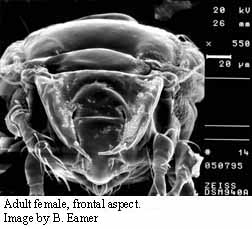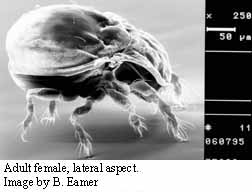

Family: Tegeocranellidae
Taxonomy: This is the only species in this small family found at La Selva. The systematics of the family, description of T. alas and other new species, and a key to species for North and Central America is in Behan-Pelletier (1997).
Habitat: This is among the few oribatid species found in the water in the experimental swamp at La Selva. Both adults and immatures are easily collected by extracting handfuls of wet vegetation from on and in the water in the swamp in Berlese funnels. This species has never been collected in the swamp during dry periods when there is no available free-standing water. Neither has it been collected from riparian habitats, such as that at Sendero Tres Rios 4000. All species in the genus are associated with habitats that periodically dry out, and adults have specialized morphological adaptations laterally on the opisthosoma to allow for air retention.
Ecology: Members of this species probably graze algae and fungi on the leaves of aquatic plants. Immatures have a slight brown-green tint, possibly reflecting this diet.
Reference: Behan-Pelletier VM. 1997. The semi-aquatic genus Tegeocranellus (Acari: Oribatida: Ameronothroidea) of North and Central America. Canadian Entomologist 129:537-577.